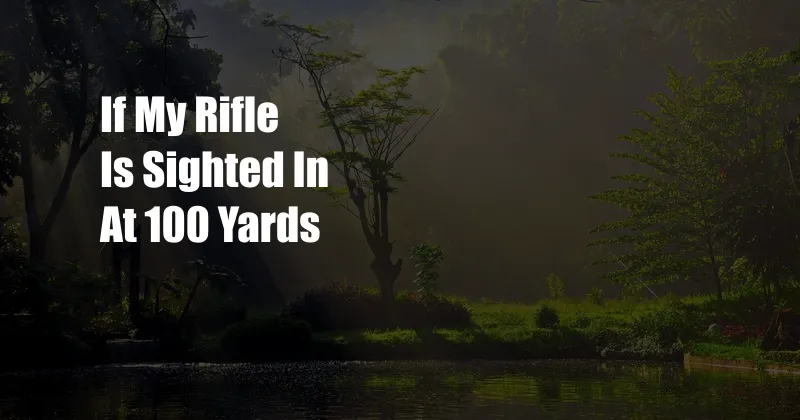
If My Rifle Is Sighted in at 100 Yards, How Will It Shoot at Other Distances?
As a seasoned marksman, I’ve spent countless hours meticulously sighting in my rifles for optimal precision at varying ranges. One common question that arises is how a rifle sighted in at 100 yards will perform at other distances. To delve into this topic, let’s explore the intricate relationship between bullet trajectory, sight settings, and target engagement distances.
Understanding Bullet Trajectory
A bullet’s trajectory refers to the path it follows from the moment it leaves the barrel to its final destination. Gravity exerts a downward force on the bullet as it travels, causing it to drop over distance. The initial velocity of the bullet and the angle at which it exits the barrel determine the shape and height of its trajectory.
Sight Settings and Point of Impact
When a rifle is sighted in, the shooter adjusts the rear sight or reticle to ensure that the bullet strikes the desired point of impact at a specific distance. Typically, rifles are sighted in at 100 yards. This distance allows for a relatively flat trajectory, making it easier to hit targets at close ranges.
Effects of Shooting at Different Distances
However, when shooting at distances other than the sight-in range, the bullet’s trajectory will deviate from the point of aim. At distances shorter than 100 yards, the bullet will strike higher than the point of aim due to its upward trajectory. Conversely, at distances beyond 100 yards, the bullet will hit lower due to the downward pull of gravity.
Calculating Bullet Drop
To compensate for bullet drop, shooters must calculate the amount of adjustment required to their sights. This adjustment, known as holdover, can be determined using ballistics tables or specialized software that takes into account the specific bullet and rifle being used.
Tips for Accurate Shooting at Various Distances
- Learn Your Rifle: Familiarize yourself with the characteristics of your rifle, including its zero distance and bullet drop at different ranges. Practice shooting at various distances to gain an intuitive understanding of the trajectory.
- Use a Rangefinder: A rangefinder provides accurate distance measurements to the target, allowing you to make precise holdover adjustments.
- Practice Holdovers: Dedicate time to practicing holdovers at different distances to develop your muscle memory and improve shot placement accuracy.
FAQ
Q: How far above or below my point of aim should I hold at different distances?
A: The amount of holdover required depends on the specific rifle and bullet combination. Refer to ballistics tables or use a ballistic calculator for precise holdover values.
Q: Can I sight in my rifle at a distance other than 100 yards?
A: Yes, but it is important to note that the rifle’s accuracy and trajectory will be optimized at the sight-in distance. Sighting in at a shorter distance, such as 50 yards, will result in a steeper trajectory at longer ranges.
Q: How does weather affect bullet drop?
A: Weather conditions, such as wind, temperature, and altitude, can influence bullet trajectory. It is important to account for these factors when making holdover adjustments.
Conclusion
Understanding the relationship between sight settings, bullet trajectory, and target engagement distances is crucial for accurate shooting at various ranges. By learning your rifle, utilizing rangefinders, and practicing holdovers, you can master the art of hitting targets consistently, regardless of the distance.
Now, I would like to ask you: Are you interested in exploring the topic of rifle sighting and long-range shooting further? If so, feel free to reach out for more information or to discuss any questions you may have.